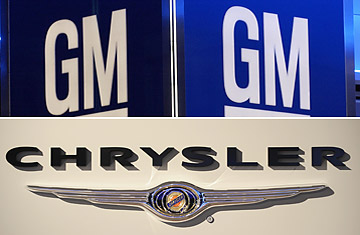
Chrysler, Fiat and the United Auto Workers reached a tentative labor agreement over the weekend that could provide the troubled American automaker with a better shot at longevity. Though complete details on the UAW accord have not yet been released, the terms are likely to closely resemble Chrysler's new agreement with the Canadian Auto Workers, ratified over the weekend. The Canadian agreement cuts labor costs to the level paid by non-union plants run by Asian companies such as Toyota, or by $19 Canadian dollars per hour (U.S. $16).
The tentative Chrysler agreement with the UAW, announced on Sunday, is said to maintain the pension fund and retiree health care fund, though it may include some reduction in healthcare benefits, just as the Canadian agreement does. Guided by the February terms of the original Treasury loans, the deal between the UAW and Chrysler also reportedly includes partial funding of the retiree healthcare trust with equity instead of cash. "We recognize this has been a long ordeal for active and retired auto workers, and a time of great uncertainty," said UAW President Ron Gettelfinger. The deal was reached, Gettelfinger said, "in the face incredibly trying circumstances." Italy's Fiat, currently in negotiations over a possible association with Chrysler, has also demanded significant labor cost savings as a prerequisite to any deal. (Read a 2-min. bio of Obama's car guru.)
On a nearly parallel track, GM announced on Monday that it was taking important new steps to reduce costs as it also struggles to avoid bankruptcy and meet a June 1 deadline from the government for restructuring its operations. In its Monday announcement, GM said that by 2010 it intends to close 13 car plants, eliminate 21,000 jobs, reduce its dealer network by 42%, and eliminate the Pontiac brand. It also announced that it has reached an agreement with the U.S. Treasury to convert 50% of the outstanding government loans to the company — or about $5 billon — into GM stock. As a result of this swap, the U.S government would become the majority shareholder of GM. The automaker also said that it is seeking an additional $11.6 billion in government loans.
The remaining party to any GM or Chrysler accord that averts bankruptcy will be the bondholders, who must agree on a reduction in the amounts owed. At Chrysler, bondholders made concessions on Friday, reducing Chrysler's $6.9 billion of outstanding debt for the second time. The bondholders had earlier agreed to accept $4.5 billion; on Friday they reduced the amount further, to $3.75 billion. A final deal with creditors much be reached by May 1. Among Chrysler's biggest bondholders are JP Morgan Chase, Citigroup, Goldman Sachs and Morgan Stanley. Even if Chrysler reaches a deal with its major creditors it may still decide to enter Chapter 11 as a way to further clean up its balance sheet.
The odds of a GM deal with bondholders may be more bleak. As part of its offer to bondholders, presented Monday, GM is offering to exchange 225 common shares for each $1,000 of principal amount of bonds. The offer covers $27.5 billion of bonds, and based on the recent price of GM stock would result in bondholders receiving less than 40% of a bond's original face value. GM's chief executive Fritz Henderson described the terms of the offer as "stern." For the swap to take place 90% of the bondholders must accept the offer. If that percentage is not met, GM will file bankruptcy. Many Wall Streeters believe the prospects for such a major swap of GM stock for debt are dubious since bondholders expect to fare better in bankruptcy. Some bondholders are said to have positioned themselves for a bankruptcy filing by buying credit default swaps, which would pay off if GM filed for Chapter 11.
